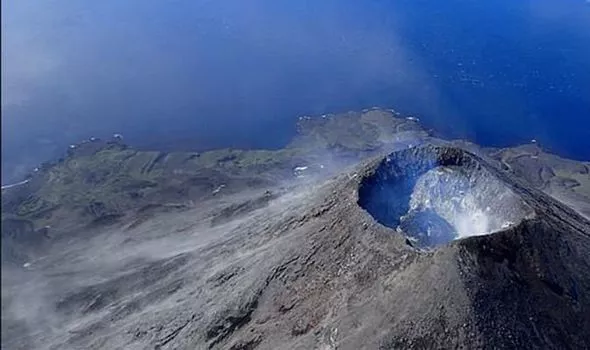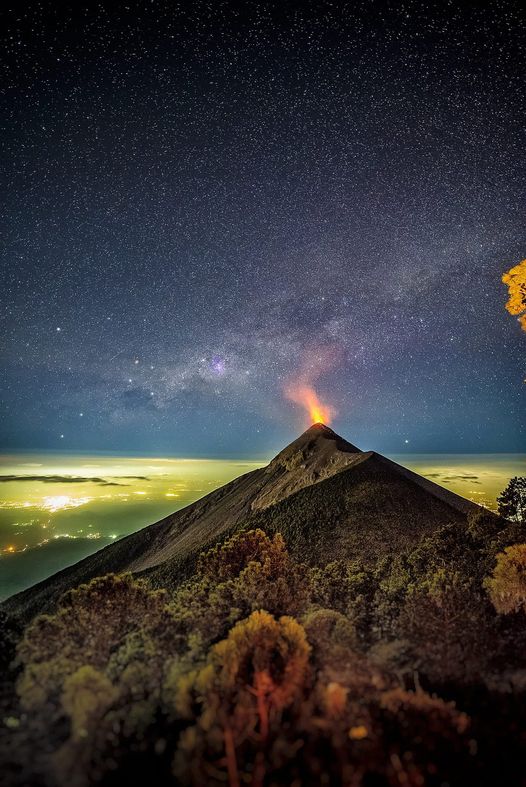The largest volcano in Guatemala, and also the highest volcano in Central America, is Volcán Tajumulco.
It stands at an impressive height of 4,220 meters (13,845 ft) above sea level and is located in the southwestern department of San Marcos, near the border with Mexico.
Tajumulco is a stratovolcano, which is a type of volcano that is built up from layers of lava, ash, and rock fragments. It is considered to be dormant, with no confirmed eruptions in historical times. However, there have been some unconfirmed reports of eruptions in the 18th and early 19th centuries.
The volcano is a popular destination for hikers and climbers, and offers stunning views of the surrounding countryside. It is also an important part of the local culture and mythology.
Here’s a list of some of the notable volcanoes found in Guatemala:
- Volcán de Fuego (3,763 meters): This active stratovolcano is one of the most iconic landmarks in Guatemala. It is known for its constant eruptions, spewing out lava and ash that can be seen for miles.
- Volcán de Agua (3,760 meters): This stratovolcano is located next to Fuego and is also considered active. It has a long history of eruptions, including a major one in 1541 that devastated the city of Antigua.
- Acatenango (3,976 meters): This stratovolcano is the highest volcano in Guatemala and is popular among hikers and climbers. It offers stunning views of the surrounding volcanoes, including Fuego and Agua.
- Volcán Pacaya (2,552 meters): This active stratovolcano is one of the most accessible volcanoes in Guatemala and is popular for day trips and hikes. It has been erupting almost continuously since 1965.
- Santa María (3,772 meters): This stratovolcano is known for its massive eruption in 1902, which was one of the largest eruptions of the 20th century. The eruption formed a new volcanic cone called Santiaguito, which has been erupting sporadically since then.
- Volcán Tajumulco (4,220 meters): This stratovolcano is the highest volcano in Central America and is considered dormant. It is located in the southwestern department of San Marcos, near the border with Mexico.
- Volcán Tolimán (3,158 meters): This stratovolcano is part of the Atitlán volcanic complex and is located on the shore of Lake Atitlán. It is considered dormant and is popular for hiking and camping.
- Volcán Atitlán (3,535 meters): This stratovolcano is also part of the Atitlán volcanic complex and forms the southern rim of Lake Atitlán. It is considered dormant and is a popular destination for hiking and kayaking.
These are just a few of the many volcanoes that can be found in Guatemala. The country is home to a diverse range of volcanic features, from towering stratovolcanoes to smaller cinder cones and lava domes.
Largest Volcano in Guatemala,
A Supervolcano called Los Chocoyos that is responsible for the formation of Lake Atitlan.
While not much information is available about this specific volcano, geologists believe it erupted approximately 85,000 years ago, causing the caldera that now holds the lake. The immense force of the eruption is what led to the lake’s impressive depth, reaching up to 341 meters.
It’s important to note that information about ancient volcanic events can be scarce and based on interpretations of geological evidence. While the existence of Los Chocoyos is well-established, details about its specific characteristics and activity may not be fully known.
The first volcanic activity in the region occurred about 11 million years ago, and since then the region has seen four separate episodes of volcanic growth and caldera collapse, the most recent of which began about 1.8 million years ago and culminated in the formation of the present caldera. The lake now fills a large part of the caldera, reaching depths of up to 340 m (1,120 ft).
The caldera-forming eruption is known as Los Chocoyos eruption and ejected up to 300 km3 (72 cu mi) of tephra. The enormous eruption dispersed ash over an area of some 6,000,000 square kilometres (2,300,000 sq mi): it has been detected from Florida to Ecuador, and can be used as a stratigraphic marker in both the Pacific and Atlantic oceans (known as Y-8 ash in marine deposits). A chocoyo is a type of bird which is often found nesting in the relatively soft ash layer.
Since the end of Los Chocoyos, continuing volcanic activity has built three volcanoes in the caldera. Volcán Atitlán lies on the southern rim of the caldera, while Volcán San Pedro and Volcán Tolimán lie within the caldera. San Pedro is the oldest of the three and seems to have stopped erupting about 40,000 years ago.
Tolimán began growing after San Pedro stopped erupting and probably remains active, although it has not erupted in historic times. Atitlán has developed almost entirely in the last 10,000 years and remains active, its most recent eruption having occurred in 1853.




 Guatemala Travel Services
Guatemala Travel Services Guatemala Travel Services
Guatemala Travel Services